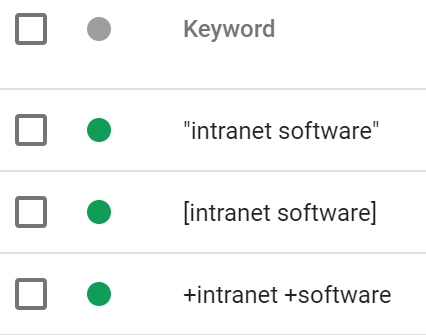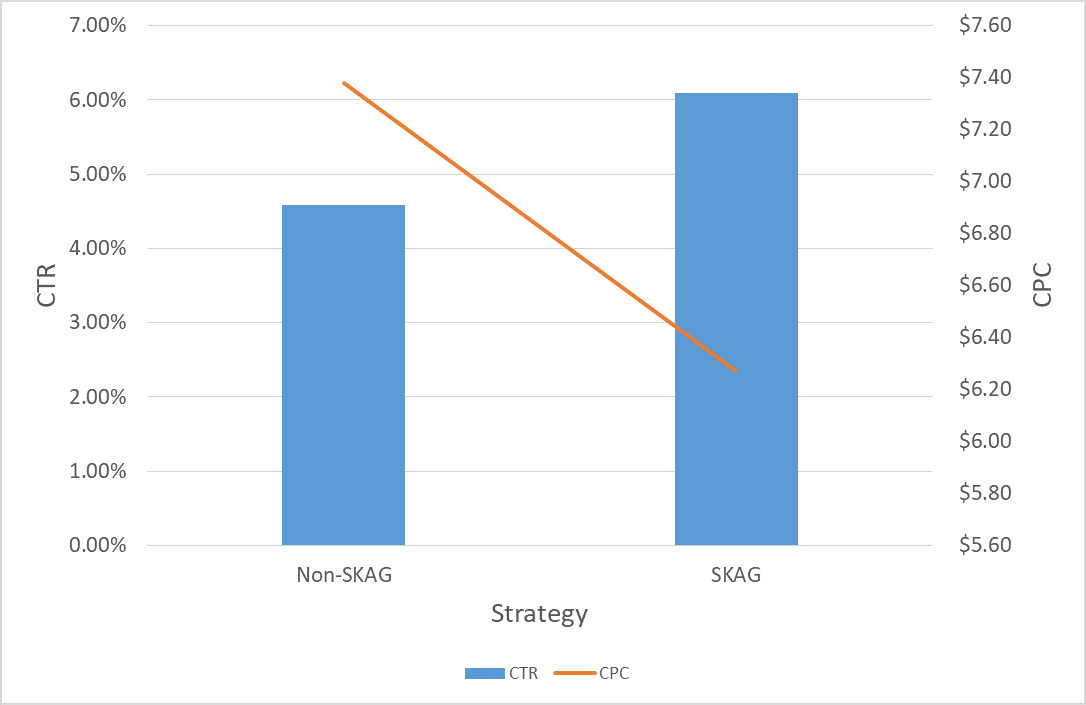Google Ads has become increasingly competitive and the average cost-per-click (CPC) has risen sharply over the past few years. With the increased costs, you can’t afford bad clicks and low quality scores. We’ve found that one simple way to increase click-through rate (CTR) and Quality Score (which impacts the position of your ad) is to switch over to single keyword ad groups. In this article I’ll explain the strategy, why use it, and the results we’ve seen.
What are single keyword ad groups (SKAG)?
True to its name, SKAG uses only one keyword per ad group, which is contrary to what Google recommends (5-20 keywords per ad group). They include a broad match modifier (BMM), phrase match, and exact match of the same keywords. You can see this in the “Intranet software” example below, which is one of our ad groups (we sell intranet software at Jostle):

Why use this strategy?
Google is secretive with their algorithms and won’t flat out say which metric contributes the most to Quality Score (QS), but the general consensus is that Expected CTR is the metric that most influences QS. And one of the best ways to increase Expected CTR is to have hyper relevant ads tied to very specific keywords. This strategy allows you to do just that.
It also allow you to improve the post-click user experience, which is also important (emphasized by Google’s Chief Economist, Hal Varian). Making post-click landing pages super relevant is easy when you use single keyword ad groups.
Here’s how I like to think about the value they present:
- Increased ad relevance = higher Expected CTR
- Higher Expected CTR = higher QS
- Higher QS = Lower CPC
- Lower CPC = Lower cost-per-acquisition
- Lower Cost Per Acquisition (CPA) = less money spent and more leads
How to set up SKAGs
Start with testing — it’s how you’ll know if this approach is best for you. Pick a few of your higher traffic ad groups and see if you can split them out. I’ll review an example of single keyword ad groups in the following section.
Keywords and ad groups
Using intranet software, let’s say that you have a generic ad group called “Intranet” that has the following keywords:
- +intranet +software
- +intranet +platform
- +intranet +solution
- +best +intranet +software
- +best +intranet +platform
- +best +intranet +solution
- +top +intranet +software
- +top +intranet +platform
- +top +intranet +solution
Using this approach (combined with dynamic keyword insertion) you can set up Google Ads so your ads are super relevant to the keywords, but my guess is that the QS in this ad group is pretty low. With many different keyword combinations this ad could potentially show up for a bunch of different search terms. There is no way that the ad can match all of those queries and the QS will suffer.
The SKAG approach looks more like this:
Ad group: Intranet software
Keywords:
+intranet +software
“Intranet software”
[intranet software]
Ad group: Intranet platform
Keywords:
+intranet +platform
“Intranet platform”
[intranet platform]
Ad group: Best intranet software
Keywords:
+best +intranet +software
“Best intranet software”
[best intranet software]
And so on and so forth. Using all three versions of the keyword is critical so your ad appears when a long tail keyword is searched.
You may ask yourself with a search term like: “best intranet software” won’t that show up for two of those ad groups? Absolutely, you’re at risk of competing with yourself here. The trick is to make sure to add negative keywords to your more general ad groups so you don’t compete with yourself. For example, for the “Intranet software” ad group, you can add negative keywords like: top, best, etc.
I’m a big fan of having a few relatively general ad groups like “intranet software” because you can then use the search term report in Google Ads to find new ad groups to add. The best way to do this is to run the search term report, sort by volume, and make a list of the keywords.
The ads
As with all Google ads, you want the display path and headline to contain the keyword. This is the main determinant for ad relevance. You also want to make sure that the ad links out to a post-click landing page that uses the keyword and has content that is highly relevant.

But I don’t want 100 ad groups!
Unfortunately, that’s too bad and the nature of single keyword ad groups. More precise targeting and specificity requires time and effort, but the results are worth it (results shown later). I’m clearly a fan of this strategy, but there are some downsides to be aware of before you consider dedicating time and energy to them:
1. Trickier to A/B test
You’ll have more ad groups, which means each ad group will have a lower volume of impressions. This means it’ll take longer to get statistically significant results when A/B testing ad copy.
2. More time and effort
You have to create more ad groups and monitor search terms so you know which negative keywords to use, which takes time. If you’re looking for a plug-and-play Google Ads strategy, this may not be for you.
The proof this strategy works
Because it has worked for Jostle. We used to follow Google’s advice and included 10-15 keywords per ad group. We were likely bidding against ourselves in a lot of ad groups and things were a little bit messy, so we decided to test out a new approach. After selecting our top 3 ad groups, we switched over to SKAGs and compared month over month results. Based on these findings it has changed the way we approach our Google Ads account structure.
Our results
We ran the test for 2 months and saw our CTR immediately jump by 33%. Those effects have continued to compound over time and we are approaching a 50% increase. We also saw our avg. CPC drop by 15%.

This drop in avg. CPC may not seem like much but over the course of the year it works out to over $10,000 in savings for us. That’s huge. Just think of all the cool stuff you could do for your next marketing campaign with that extra room in your budget.
But will it work for me?
Most likely, yes. There are a lot of companies online that were able to improve their metrics using SKAG. Sam Owens from PPC Hero was able to increase CTR by 22% and decrease CPA by 50%. Clicteq was able to increase CTR by 32% and decrease CPA by 11%.
That said, converting your entire account over to single keyword ad groups is time-consuming so test it out first. Take your top 5 ad groups and break them out into a series of ultra-specific ones. If it doesn’t work, you waste a few hours of your time. But if it does work, you could save some serious money and substantially lower your CPA.
The results are beautiful
SKAG may not be pretty to say, but the results are beautiful. With single keyword ad groups, you can create ads that are hyper-relevant to the keywords, which will increase Expected CTR and QS. In turn, this will lower your CPC and ultimately lower your CPA.
The downsides don’t outweigh the benefits of single keyword ad groups so it’s in your best interest to spend the time creating and experimenting with them. We’ve seen our CTR jump by 33% and our CPC drop by 15%!
Once you’ve finished setting up your ad groups, ensure that you’re sending all search users to a relevant and personalized post-click landing page. That way you can continue providing a cohesive user experience and increasing your chance at conversion. If you neglect this part, all that hard work customizing your campaigns will essentially go to waste.
Don’t ignore the post-click stage anymore. Provide every prospect with a personalized experience from start to finish. Sign up for an Instapage Enterprise demo today.
About the author
Dustin is the Growth Marketing Director at Jostle Corporation. As part of a scrappy marketing team, he is constantly on the look-out for new ways to generate business and interest in a crowded marketplace. Jostle’s mission is to help build extraordinary workplaces. Their People Engagement® platform is a complete, intuitive intranet that helps you improve employee engagement, express your culture, and make communication happen.

See the Instapage Enterprise Plan in Action.
Demo includes AdMap™, Personalization, AMP,
Global Blocks, heatmaps & more.
